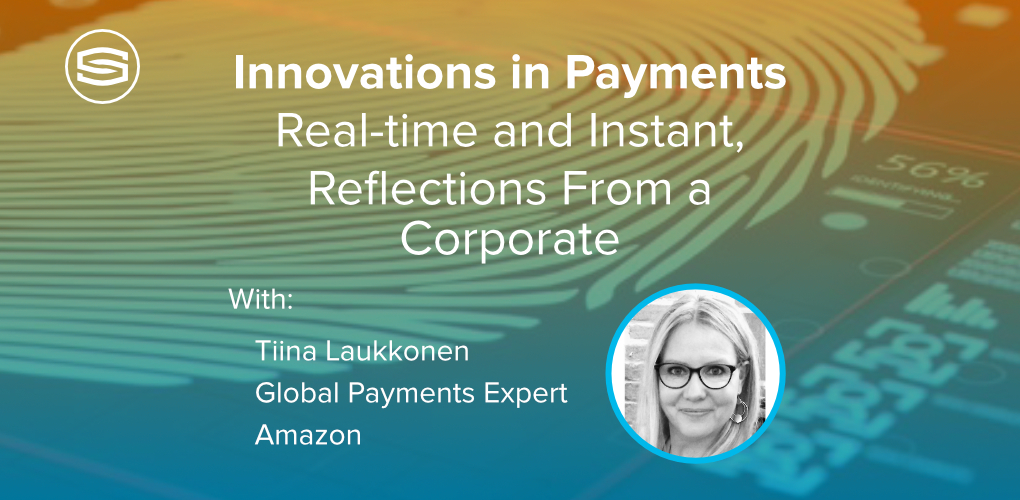
Insights & Opinions
Innovations in Payments, Reflections From a Corporate
Wed, 11 May 2022


On April 28, I invited Tiina Laukkonen, Global Payments Expert at Amazon, for an interactive session. I met her a few times at a conference in London, Payments International. Tiina is responsible for building & delivering a payment solution strategy for Amazon's global payee population, a user group that ranges from large corporate vendors to individuals who provide digital content.
This diversity made me think it'd be a great idea to invite her for an Afterwork session to discuss how corporates look at innovations in the payments industry and confirm or counter what the many special guests from the banking industry shared with us.
The enormous potential of ISO20022
When we asked the audience first about their expectations on ISO20022, 50% of the people shared that it would ignite innovation.
Tiina shared that Amazon was an early adapter of ISO20022 standards. She is a big fan of this not-so-new standard: "ISO 20022 is a massive opportunity for the industry to standardise, and I think it will benefit both banks and corporates."
The opportunity lies in the data integrity element. If everyone uses the same messaging standards and data fields, ISO20022 can hopefully overcome issues like truncation of data.
Beneficiaries pay the price of truncation because they cannot properly reconcile their receivables if part of the information gets lost somewhere in the process. Tiina: "To me, resolving this is not innovation. It is something that should have been in place a long time ago."
She added another side note for the banks, saying there is much emphasis on the large majority of payment transactions that go well, and not enough on the exceptions, the payments that don't process as expected. This exception handling is costly. It requires resources both from the bank and corporates to handle inquiries, that often go back and forth for a long time over emails.
To conclude, Tiina shared: "I'm passionate about XML and the opportunity to help us and the banks automate and perform end-to-end reconciliation, have systems recognise and manage failures instead of using a whole lot of people for that small percentage that fails."
APIs are needed, for the right use cases
Tiina is a fan of APIs. For instant payments and bank account validation, API-based solutions are essential. Yet, she misses critical thinking of some APIs developers: "they sometimes place too much emphasis on building an API solution only and ignoring completely what the potential corporate use cases would be to continue using a file-based solution."
She explained it with the example of corporates that often consolidate all payment information upstream and send their instructions e.g. once a week. There’s no benefit to send these large bulk volumes over APIs.
It is important for banks to understand their customers’ end-to-end flows. When this flow is real-time all the way, then APIs are a must. However, if upstream is still batched into large volumes, a file solution may just be the right one. The future will bring more relevant use cases of APIs and a lot more usage of APIs. Nevertheless, Tiina believes that batch-based processing is here to stay and will continue co-existing with the APIs.
SWIFT gpi as a good start for transaction tracking
A few years back, SWIFT started implementing SWIFT gpi to improve the experience of making a payment via the SWIFT network. gpi includes a track-and-trace feature across the value chain to allow immediate action when a transaction is held up somewhere in the process.
Although it is a significant improvement and a good start for further development, Tiina sees a few weaknesses for a company like Amazon with respect to SWIFT gpi. The first concern is that it is only available for wire transfers today. The majority of payments are processed through local clearinghouses that are not connected to this track-and-trace solution.
On top of that, Tiina noted that end-to-end transaction tracking should mean "from the moment it leaves the bank to the moment it is credited to the beneficiary bank account". Too often, the payment may go into exception IN the bank, and it is these internal bank steps which are not transparent to corporates.
IBAN-Name Check for corporates
Living in the UK, Tiina understands the value of payee name validation. She experienced it as a consumer, but it is only available in online banking. Her wish is that banks will soon provide this service to corporates as well.
Tiina: "We should be talking holistically about the payee validation. We shouldn't stop at name and account validation because there is a lot of other critical information needed to make a successful payment. For example, you may need to have a tax ID of the beneficiary, whether it's a company or an individual, in some countries."
Another example is the one where certain clearing channels mandate the beneficiary's address in a specific format. For corporates, it would be helpful to have a service to confirm they use the correct format to reduce the number of rejected transactions.
A proactive approach of validation instead of fixing the problem would be much less expensive for all parties, and would improve the payee experience.
Conclusion
To conclude, Tiina reached out to the banking industry, saying that we should spend more time on co-development, talking to clients during the development phase and working together instead of presenting a finished product based on assumptions that may not cover a corporate’s expectations.
Full automation and AI are on top of her list to help improve reconciliation and straight-through-processing rates.
She brought a lot of food for thought, and I look forward to discussing these topics in further depth in future sessions.



